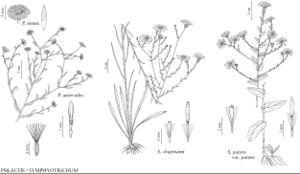Psilactis
Mem. Amer. Acad. Arts, n. s. 4: 71. 1849.
| Taxon | Illustrator ⠉ | |
|---|---|---|
 | Psilactis tenuis Symphyotrichum chapmanii Symphyotrichum patens var. patens | Bee F. Gunn Bee F. Gunn Bee F. Gunn |
Annuals or biennials [perennials], 15–150 cm (taprooted). Stems erect or weakly ascending, simple, glabrate to densely hairy and glandular. Leaves: basal and cauline (basal and proximal cauline withering and falling by flowering); alternate; petiolate, distal sessile; basal blades 1-nerved, obovate to linear-oblanceolate; proximal cauline blades lanceolate, elliptic, or obovate to linear-oblanceolate, margins entire, coarsely toothed or pinnately lobed, faces appressed-hairy; distal blades ovate to lanceolate to linear, smaller, margins entire, faces stipitate-glandular and/or appressed-hairy. Heads radiate, borne in loosely corymbiform arrays. Involucres turbinate to hemispheric, (2–9 ×) 4–18 mm. Phyllaries 30–45 in 2–3 series, (reflexed in fruit) 1-nerved (flat), oblong or lanceolate to linear, equal or unequal, herbaceous, bases usually indurate, margins scarious, herbaceous faces stipitate-glandular. Receptacles flat to convex, pitted to verrucose, epaleate. Ray-florets 10–70, pistillate, fertile; corollas white to blue or purple (tightly coiled at maturity). Disc-florets 15–150, bisexual, fertile (pappose); corollas yellow, lobes often purple, tubes shorter than funnelform throats, lobes 5, erect, deltate to lanceolate (glabrous or sparsely appressed-hairy). Cypselae: of ray fusiform to obovoid, of disc fusiform to clavate or obovoid, compressed, 5–18-nerved, faces sparsely to densely appressed-hairy (disc glabrate or glabrous in P. heterocarpa); pappi: ray 0; disc persistent, of 20–50, white to tawny, unequal, barbellate, apically attenuate bristles in 1–2 series. x = 3, 4, 9.
Distribution
sw United States, Mexico, South America (Colombia), South America (Peru)
Discussion
Species 6 (5 in the flora).
Molecular evidence from nuclear ribosomal DNA ITS and ETS sequences has indicated that Psilactis is closely related to Symphyotrichum (J. C. Semple et al. 2002; D. R. Morgan 1997, 2003).
Psilactis odysseus (G. L. Nesom) D. R. Morgan is the only species of the genus that does not occur in the flora area. It is found in the Mexican states of Nuevo León and Tamaulipas and is distinguished from the other five species by being a monocephalous, rhizomatous perennial.
Arida crispa and A. coulteri have been placed in Psilactis in the past because they have epappose ray florets (B. L. Turner and D. B. Horne 1964). They were placed in what is now Arida by R. L. Hartman (1990) because they produce flavones and have chromosome numbers of n = 5.
Selected References
Lower Taxa
Key
| 1 | Involucres 2–4 mm; ray laminae 1–4 mm | Psilactis brevilingulata |
| 1 | Involucres 4–8 mm; ray laminae 4–15 mm | > 2 |
| 2 | Phyllaries 0.3–0.7 mm wide; involucres broadly turbinate | > 3 |
| 2 | Phyllaries 0.6–1.2 mm wide; involucres hemispheric | > 4 |
| 3 | Disc cypselae glabrate or glabrous, 2–3 mm, length 1.5–2 times ray cypselae | Psilactis heterocarpa |
| 3 | Disc cypselae appressed-hairy, 1.5–2.5 mm, length 1–1.4 times ray cypselae | Psilactis tenuis |
| 4 | Bases of distal cauline leaves cordate to auriculate, clasping; involucres 5–8 mm; receptacles 4–6 mm diam | Psilactis gentryi |
| 4 | Bases of distal cauline leaves cuneate to slightly cordate, sometimes slightlyclasping; involucres 4–5 mm; receptacles 1.8–4 mm diam | Psilactis asteroides |
"[" is not declared as a valid unit of measurement for this property."]" is not declared as a valid unit of measurement for this property.